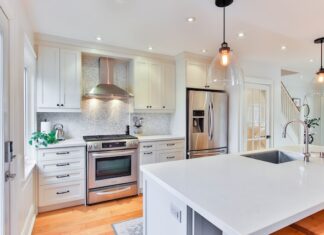When it comes to designing and decorating a bedroom, lighting plays a critical role in creating the right ambiance and atmosphere. Lighting can make a small room look bigger, a dull room look brighter, and even set the mood for relaxation or intimacy. In this article, we’ll explore the different types of bedroom lighting, their benefits, and how to choose the best lighting for your space.
Types of Bedroom Lighting
Ambient Lighting
Ambient lighting, also known as general lighting, is the primary source of light in a room. It provides overall illumination and sets the tone for the entire space. Examples of ambient lighting include ceiling-mounted fixtures, chandeliers, and pendant lights.
Task Lighting
Task lighting is designed to help you perform specific tasks in the bedroom, such as reading, getting dressed, or applying makeup. It’s usually brighter and more focused than ambient lighting. Examples of task lighting include bedside lamps, desk lamps, and floor lamps.
Accent Lighting
Accent lighting is used to highlight specific features in the bedroom, such as artwork, sculptures, or architectural details. It’s usually the most decorative type of lighting and can be achieved with track lighting, wall sconces, or picture lights.
Natural Lighting
Natural lighting refers to the use of natural light sources, such as windows or skylights, to illuminate the room. It’s the most energy-efficient and eco-friendly type of lighting and can make a room feel more spacious and inviting.
Benefits of Proper Bedroom Lighting
Improved Sleep Quality
Studies have shown that the right type of lighting can improve sleep quality and help regulate your body’s internal clock. Dimming the lights and using warm, amber tones can help your body prepare for sleep and reduce the effects of blue light on melatonin production.
Increased Productivity
Proper lighting can also increase productivity by reducing eye strain and fatigue. Task lighting, in particular, can make it easier to read or work on a computer without squinting or straining your eyes.
Better Mood and Relaxation
The right lighting can also have a positive effect on your mood and help you relax. Soft, warm lighting can create a cozy and inviting atmosphere, while bright, cool lighting can be energizing and invigorating.
Enhanced Aesthetics
Finally, the right type of lighting can enhance the aesthetics of your bedroom by highlighting key features and creating depth and contrast. Accent lighting, in particular, can add a touch of drama and sophistication to your space.
How to Choose the Best Bedroom Lighting
Consider Your Needs
Before choosing bedroom lighting, consider your needs and how you use the space. Do you read in bed? Do you have a desk where you work? Do you need accent lighting to highlight artwork or architectural features?
Choose the Right Bulbs
When choosing bulbs for your bedroom lighting, consider the color temperature, brightness, and energy efficiency. Warm, amber tones are ideal for creating a cozy and relaxing atmosphere, while brighter, cooler tones are better for task lighting.
Layer Your Lighting
Layering your lighting can create depth and contrast in your bedroom and allow you to adjust the lighting based on your needs. Use a combination of ambient, task, and accent lighting to create the perfect ambiance.
Use Dimmers
Dimmers allow you to adjust the brightness of your lighting and create a more customizable atmosphere in your bedroom. They’re especially useful for ambient lighting, where you may want to create a cozy and romantic atmosphere.
FAQs
Q: Can I use LED lights in my bedroom?
A: Yes, LED lights are a great option for bedroom lighting as they’re energy-efficient, long-lasting, and can be dimmed to create the perfect ambiance.
Q: What’s the best way to position my bedside lamps?
A: Bedside lamps should be positioned at a height that’s comfortable for reading in bed, usually around 20-24 inches from the top of the mattress. They should also be positioned so that the light shines directly onto the page or screen and doesn’t shine in your eyes.
Q: How many light sources do I need in my bedroom?
A: It depends on the size of your bedroom and your personal preferences. As a general rule, you should aim to have at least three sources of light in your bedroom, including ambient, task, and accent lighting.
Q: What type of bulbs should I use for task lighting?
A: For task lighting, choose bulbs that are brighter and cooler in tone, such as daylight or cool white bulbs. These will help reduce eye strain and make it easier to read or work in your bedroom.
Q: Can I install dimmer switches myself?
A: If you have some electrical experience, you may be able to install dimmer switches yourself. However, it’s always best to consult a professional electrician to ensure that the wiring is safe and up to code.
Conclusion
Proper bedroom lighting is essential for creating a comfortable, functional, and stylish space. By understanding the different types of lighting, their benefits, and how to choose the best lighting for your needs, you can create a bedroom that’s both functional and beautiful. Remember to consider your needs, choose the right bulbs, layer your lighting, and use dimmers for a customizable atmosphere. With these tips and tricks, you can create a bedroom that’s perfect for sleeping, working, and relaxing.
If you found this article helpful, please share it on social media and leave a comment below with your thoughts and questions. We’d love to hear from you!
Source: http://www.mattwietersfacts.com/












